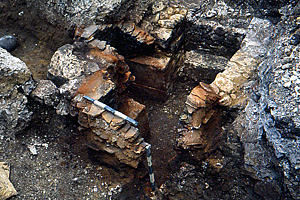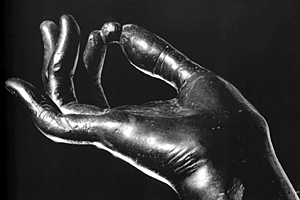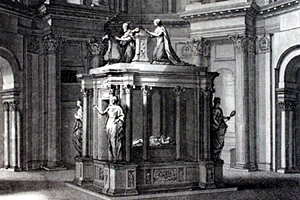- Home
- Men and women
- Ponce Jacquio (ca. 1515 – 1570)
- Saint Denis (died circa 250)
- Queen Arnegunde (510/520 – 580/590)
- Hunus the monk (died between 838 and 845)
- Abbot Suger (ca 1081 - 1151)
- Pierre, Eudes and Raoul de Montreuil (died in 1267, 1287, and ca. 1318)
- A pilgrim
- A baker
- A traveller: Arnold Van Buchel, 1585
- An artist : Ponce Jacquio (ca. 1515 – 1570)
Objects from the foundry workshop, circa 1580.
© UASD / J. Mangin
In the second half of the sixteenth century, a foundry was set up on a parcel of land to the north of Rue du Saulger. It consisted of a flat-tile furnace in which metal was melted in crucibles made of fireclay. The foundry produced bells, as shown by the exavation of a number of mould fragments.
Bronze-smelting furnace during excavation.
© UASD / J. Mangin.
The artisan appears to have been involved in commissions for funeral monuments for the abbey church. Indeed, elements of plaster moulds for making small terracotta statues were found in the furnace fill.
Hand holding a diamond between thumb and index finger; detail of Strength, by Germain Pilon.
© UASD / J. Mangin
Plate from the History by Dom Michel Félibien depicting an interior view of the Valois mausoleum with the tomb of Henry II and Catherine de Medicis, by A. le Blond, 1706.
A stylistic analysis of these sculpture fragments reveals striking similarities with the work of Ponce Jacquio, a French sculptor who-between 1563 and 1570-worked with Germain Pilon on the tomb of Henry II and Catherine de Medicis. In 1563, the artist was paid 450 pounds for creating the ceramic and plaster models for this tomb.
Hand from a fragment of a terracotta statue found in the foundry workshop.
© Cl. Sauvageot
Thermo-remanent magnetism analysis of the furnace dates its last use to around 1580, or some ten years after Ponce's death. We can imagine that, in his shop, the bronze-smith kept the moulds and a few models that he had created for the famous sculptor.





